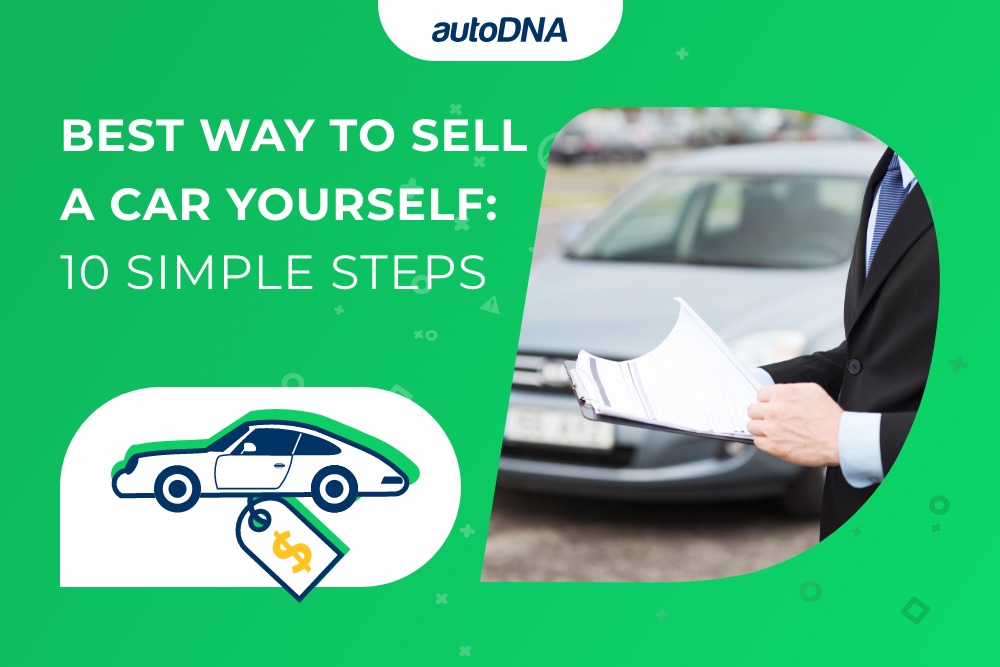
Best Way to Sell A Car Yourself: 10 Simple Steps
Table of Contents
Table of Contents
With the help of autoDNA discover the best way to sell a car yourself with our 10 simple steps. Maximize value, attract buyers and… finalize the sale smoothly!
Selling your car online privately can be a rewarding process that allows you to get the best possible price. However, it requires careful planning and execution to ensure a smooth and successful transaction.
By following these 10 simple steps, you’ll prepare your car, attract serious buyers, and finalize the sale confidently.
- Prepare your car for sale – Clean the interior and exterior thoroughly, fix minor issues, and consider professional detailing to enhance its appeal.
- Gather essential documents – Ensure you have the car title, maintenance records, and warranty documents ready for the buyer.
- Determine your car’s value – Use tools like autoDNA’s VIN Decoder to establish a fair price.
- Set a competitive asking price – Research similar listings and consider pricing slightly below competitors to attract buyers quickly.
- Create a compelling listing – Write an honest and detailed description, highlight standout features, and use high-quality photos.
- List your car on reliable platforms – Post your ad on trusted sites like Facebook Marketplace to reach the right audience.
- Respond to inquiries professionally – Be prompt and transparent when answering potential buyers’ questions about your car.
- Conduct safe test drives – Verify the buyer’s credentials, meet in a public location, and accompany them during the test drive.
- Negotiate effectively – Be prepared to negotiate but set a minimum price you’re willing to accept.
- Finalize the sale – Complete the necessary paperwork, transfer ownership, and cancel your insurance policy after the sale.
Best Way to Sell Vehicle Yourself – How to Prepare Your Car to Sell?
When selling your car, first impressions count, and presenting it in the best possible condition can significantly increase its appeal to potential buyers. Start by giving your car a thorough cleaning, both inside and out. Wash the exterior to remove dirt, grime, and any stubborn stains.
Pay special attention to the wheels and windows, as sparkling surfaces make a strong impact. For the interior, vacuum the carpets, seats, and floor mats, ensuring there’s no dust or debris left behind. Wipe down all surfaces, including the dashboard, console, and door panels, using appropriate cleaning products to leave them spotless and refreshed.
For an added touch of professionalism, consider investing in detailing services. Professional detailing can restore your car’s shine, remove minor scratches, and leave it looking almost brand new.
Additionally, take the time to fix any minor issues. Replace burnt-out bulbs, worn-out wiper blades, and faulty fuses. Check your tire condition, ensuring they are properly inflated and have sufficient tread depth, as buyers will notice these details.
A well-maintained car not only attracts more buyers but also justifies a higher asking price.
These simple steps demonstrate that you’ve taken good care of your vehicle, increasing the buyer’s confidence and potentially speeding up the sales process by being transparent about the car’s condition.
What Should I Do Before Selling My Car?
Preparation is key to ensuring a smooth and successful car sale. Taking the time to get everything in order not only makes the process easier but also builds trust with potential buyers. Start by gathering all necessary documents.
These include the car’s title, which proves ownership, maintenance records that show the vehicle’s upkeep, and any warranty information that might still be valid. Additionally, make sure to have the vehicle identification number (VIN) and the license plate number ready, as these are crucial for generating accurate offers. Having these documents ready demonstrates transparency and can help justify your asking price.
Next, check your local laws regarding private car sales. Regulations vary by region, so it’s important to ensure compliance with any specific requirements, such as emissions testing, providing a bill of sale, or transferring the title properly. Ignoring these steps could lead to delays or complications in finalizing the transaction.
Before showing your car to potential buyers, take a moment to remove all personal items from the vehicle. Check under seats, in the glove compartment, and in the trunk to ensure nothing is left behind. Additionally, cancel any subscriptions linked to the car, such as toll passes, parking permits, or satellite radio services. Forgetting to cancel these could result in unnecessary charges or inconvenience for the new owner.
By addressing these tasks upfront, you set the stage for a seamless sale and demonstrate your professionalism, making the process easier for both you and the buyer.
How Do I Determine the Value of My Car?
Setting a fair and competitive price is essential to attracting buyers and completing a successful sale. Researching your car’s market value, including its retail value, is the first step in this process.
Start by using reliable online tools, such as autoDNA’s VIN Decoder.
Several factors will influence the final valuation of your car. Mileage plays a significant role; lower mileage typically equates to a higher value, as it suggests less wear and tear. The condition of your car is another key consideration — vehicles in excellent condition with no mechanical or cosmetic issues will command a higher price than those requiring repairs. Additionally, unique or desirable features, such as upgraded trim packages, advanced safety systems, or recent maintenance (like new tires or brakes), can positively impact your car’s value.
When determining your asking price, compare your car to similar models listed for sale in your area. Look at local classified ads, dealer listings, and online marketplaces to understand what buyers are willing to pay. This approach ensures your price is competitive and in line with the market. If you want to attract buyers quickly, consider setting your price slightly below the competition, but always leave room for negotiation.
By thoroughly evaluating these factors and using the right tools, you can confidently establish a price that reflects your car’s true worth, appealing to buyers while ensuring you get the best deal.
Should I Get My Car Inspected Before Selling?
While not a strict requirement, getting a pre-sale inspection is a smart move that can make your car more appealing to potential buyers. A professional inspection by a trusted mechanic provides a detailed assessment of your car’s current condition, identifying any issues that could affect its value or performance. By addressing these problems upfront, you can avoid surprises during the sales process and present your car in the best possible light. Additionally, many sellers can obtain an instant cash offer based on the inspection results, significantly reducing the hassle compared to traditional selling methods.
Buyers appreciate transparency, and having a recent inspection report to share demonstrates your honesty and commitment to a fair transaction. It reassures buyers that the vehicle is in good condition and helps build trust, which can ultimately speed up the sale process. Additionally, this proactive step can give you an edge over competing sellers who may not have taken the same initiative.
For sellers, an inspection is also a valuable tool for pricing your car accurately. Knowing exactly what repairs or maintenance might be needed allows you to factor those costs into your asking price or negotiate more confidently. If your car is in excellent condition, a clean inspection report can even justify a higher price.
In short, while a pre-sale inspection is not mandatory, it’s a worthwhile investment that can save time, build trust, and potentially increase your car’s value, making the sale smoother and more successful for both you and the buyer.
How to Calculate the Best Price for Your Car?
Determining the best price for your car at a reasonable price is crucial to attracting buyers and ensuring a successful sale. To start, research similar listings in your area to understand the market. Look for cars with the same make, model, year, mileage, and condition as yours. Platforms like Facebook Marketplace can provide a wealth of information on what other sellers are asking for vehicles comparable to yours.
When setting your price, consider positioning it slightly below your competitors. This strategy can help your listing stand out and attract buyers more quickly, especially in a competitive market. However, be cautious not to undervalue your car, as this could lead to unnecessary losses. Highlight any unique features or recent upgrades your car has, such as new tires, advanced safety features, or a pristine maintenance record, which could justify a slightly higher price.
Be prepared to negotiate, as most buyers expect some flexibility in pricing. To protect your bottom line, set a minimum price you’re willing to accept before listing the car. This ensures that you’re not caught off guard during negotiations and helps you avoid accepting an offer that doesn’t meet your expectations.
By taking these steps—researching comparable vehicles, pricing competitively, and preparing for negotiations—you can calculate the best price for your car, striking a balance between attracting buyers and maximizing your profit.
How to Attract Potential Buyers
To successfully sell your car, you need to capture the attention of potential buyers with a compelling and well-crafted listing. Start by writing a detailed and engaging description that highlights all the important details about your car. Include its make, model, year, mileage, and overall condition. These are the key pieces of information that buyers look for when deciding whether a vehicle meets their needs.
Make your listing stand out by emphasizing any unique features or upgrades your car has, such as leather seats, a premium sound system, advanced safety technology, or recent maintenance work like new tires or a fresh oil change. Clearly communicate these selling points to make your vehicle more attractive to potential buyers. If your car has been well-maintained, mention this prominently, as it reassures buyers of its reliability.
Honesty is essential in building trust with potential buyers. If your car has any known issues, such as minor scratches, a replaced part, or a history of repairs, disclose these upfront. Transparency not only fosters confidence but also helps you avoid disputes later in the sales process.
Pair your description with high-quality photos that showcase your car from multiple angles, including the interior, exterior, and engine. Clean, well-lit images can significantly increase interest in your listing. By presenting your car clearly and honestly, you create a listing that attracts serious buyers and makes them more likely to reach out to you.
What Tips Can Help Me Market My Car Effectively?
Marketing your car effectively is essential to attracting the right buyers quickly. Selling your car through a private party can often yield higher cash returns compared to dealerships. The first and most important step is to use high-quality photos. Take clear, well-lit pictures of your car from multiple angles, including the front, back, sides, interior, and under the hood. Highlight details that buyers care about, like the condition of the seats, dashboard, and tires. Clean, professional-looking images can make your listing stand out and give buyers a positive first impression.
Next, list your car on reliable platforms where buyers are actively searching for vehicles. Popular options include Facebook Marketplace. Each platform has its audience, so consider posting on multiple sites to maximize your reach. Be sure to follow any specific guidelines for creating a listing on these platforms to ensure it appears professional and trustworthy.
In your listing, use targeted keywords to improve visibility and appeal. Words like “low mileage,” “well-maintained,” “garage-kept,” or “one-owner” can grab buyers’ attention and help your car appear in search results. These terms convey value and reliability, making your car more attractive to potential buyers. Additionally, include key details about the car’s history, such as “no accidents” or “recently serviced,” to reinforce its quality.
By combining high-quality visuals, strategic platform selection, and effective use of keywords, you can create a powerful marketing strategy that attracts serious buyers and increases your chances of selling your car quickly and at a great price.
How Important Are Photos in Selling a Used Car?
When it comes to selling a used car, photos can make or break a sale. The images you provide are often the first impression potential buyers have of your vehicle, and they play a critical role in attracting attention to your listing. A well-presented car with high-quality photos is more likely to generate interest and inquiries than one with poorly lit or unclear images.
Invest time in taking clear, well-lit pictures of your car from multiple angles. Showcase the exterior by capturing the front, rear, sides, and any unique design elements. For the interior, focus on the dashboard, seats, and any standout features, such as a touchscreen display or leather upholstery. Don’t forget to include photos of the engine and tires, as buyers often want to assess the car’s mechanical and physical condition.
Close-ups of standout features or upgrades can further enhance your listing. Highlight details such as alloy wheels, a sunroof, or recent maintenance work, like new tires or brakes. These images can set your car apart from similar listings and provide buyers with the assurance they need to move forward.
By prioritizing high-quality photos, you not only attract more potential buyers but also convey professionalism and transparency. This approach builds trust and increases the likelihood of selling your car quickly and at a competitive price. In the world of online car sales, great photos are not just important—they are essential.
Write an Effective Advertisement
Creating an engaging and effective advertisement is key to attracting serious buyers for your car. A well-written ad not only highlights the best aspects of your vehicle but also establishes trust and encourages potential buyers to take action. Here’s how to craft an ad that stands out:
Start with a clear and attention-grabbing headline. Include essential details such as the car’s make, model, year, and a standout feature. For example, “2018 Toyota Corolla – Low Mileage, Excellent Condition” immediately informs buyers about the key selling points.
In the body of the ad, provide a detailed description of the car. Mention important information such as mileage, condition, service history, and any unique features or upgrades, like a sunroof, premium sound system, or recent maintenance. Be honest about any minor flaws or repairs needed, as transparency builds trust with buyers.
Use keywords that buyers are likely to search for, such as “one-owner,” “well-maintained,” or “low mileage.” This improves the visibility of your ad on online platforms and ensures it reaches the right audience.
Include high-quality photos to showcase the car from all angles, including the exterior, interior, engine, and tires. Clean, well-lit images make your car more appealing and help buyers visualize owning it.
Finally, add a call to action at the end of your ad. Encourage buyers to contact you by stating, “Call or message me for more details” or “Schedule a test drive today!” Make sure to provide your preferred contact information and respond promptly to inquiries.
Conducting Test Drives Safely
Allowing buyers to test drive your car is an essential step in the selling process, as it lets them evaluate the vehicle’s performance and comfort. Private sales can be particularly challenging, especially when dealing with outstanding finance. However, safety should always come first. By taking the right precautions, you can protect yourself and your property while ensuring a positive experience for potential buyers.
What Should I Know About Allowing a Buyer to Test Drive My Car?
Allowing a potential buyer to test drive your car is a critical step in the sales process, as it helps them assess the vehicle’s performance and comfort. For those looking for a fast sale, many platforms and dealerships offer instant cash offers, making the transaction quick and convenient. However, it’s important to take precautions to ensure your safety and protect your property during this stage.
Verify the buyer’s credentials before agreeing to a test drive. Always ask for a valid driver’s license and proof of insurance. This not only confirms that the buyer is legally permitted to drive but also ensures they have coverage in case of an accident during the test drive. If the buyer cannot provide these documents, it’s best to decline the request.
Choose a safe, public meeting location for the test drive. Avoid inviting strangers to your home. Instead, meet in a well-lit and busy area, such as a shopping center parking lot, gas station, or public park. These locations reduce the risk of fraud or theft and provide a neutral space for the transaction.
Accompany the buyer during the test drive to maintain control of the situation. Riding along allows you to guide the buyer through a pre-determined route, ensuring they don’t stray far from the meeting point. Select a route that offers a mix of city streets and highways so the buyer can fully evaluate how the car handles in different driving conditions. While riding along, observe their driving behavior to ensure they treat your car respectfully and responsibly.
By following these steps, you can facilitate a safe and efficient test drive experience for both you and the buyer, building trust and confidence in the transaction while protecting yourself and your vehicle.
How Can I Ensure My Safety During a Test Drive?
Ensuring your safety during a test drive is crucial, as you are not only dealing with a potential buyer but also entrusting them with your car. If you are selling an old car, it’s important to be extra cautious during this process. By following a few precautions, you can minimize risks and make the process safer.
Trust your instincts. If something feels off about the buyer, their behavior, or their requests, it’s better to cancel the test drive than to put yourself in a potentially unsafe situation. A genuine buyer will understand your concerns, so don’t hesitate to prioritize your safety over the possibility of making a sale.
Share the meeting details with a trusted friend or family member. Let them know where and when you’re meeting the buyer and what route you plan to take for the test drive. If possible, bring someone with you to the meeting for added security. Having another person present can deter any dishonest intentions and provide additional support if needed.
Keep your phone fully charged and within easy reach. In case of an emergency, you’ll need to call for help quickly. Having your phone readily accessible ensures you’re prepared to handle unexpected situations, whether it’s contacting a friend, the police, or roadside assistance.
By following these steps, you can confidently manage test drives while prioritizing your safety, creating a secure environment for both you and the buyer.
Finalizing the Sale
Once you’ve found a buyer for your car, it’s time to finalize the sale. Consider the option to trade in your vehicle at a dealership for convenience and potential tax savings. This step involves preparing the necessary documents, completing the legal requirements, and taking post-sale actions to ensure the process is fully wrapped up.
What Documents Do I Need to Complete the Sale?
Completing a car sale involves preparing and exchanging several key documents. These not only ensure the legal transfer of ownership but also protect both you and the buyer from potential disputes. If you are considering trading in your vehicle, the trade-in value can contribute towards the purchase of a new car. Here’s a breakdown of what you’ll need to finalize the transaction:
The car’s title for transfer. The title is the most important document in the sale process, as it proves ownership. You’ll need to sign and transfer it to the buyer as required by local laws. Double-check all information for accuracy to avoid delays in processing the transfer. If the car is financed and the title is held by a lender, work with them to ensure the lien is released before completing the sale.
A bill of sale. This document outlines the key details of the transaction and serves as a receipt for both you and the buyer. It provides a record of the agreed price, date of sale, and the parties involved, offering legal protection should any disputes arise later.
Warranty documents or service records. If your car is still under a manufacturer or extended warranty, include these documents to reassure the buyer. Service records, showing regular maintenance and repairs, can further build confidence in the vehicle’s condition and help justify your asking price.
The bill of sale is a crucial document and should include:
- The car’s make, model, and VIN (Vehicle Identification Number). This identifies the exact vehicle being sold.
- Sale price and payment method. Specify the agreed price and whether payment is made in cash, via check, or another method.
- Buyer and seller details. Include names, addresses, and contact information for both parties. Both the buyer and seller must sign the bill of sale to make it legally binding.
Make sure all documents are completed accurately and legibly to avoid complications in transferring ownership. Before handing over the keys, verify that the buyer has received all necessary paperwork and understands the next steps for registering the vehicle in their name. By organizing these documents and following proper procedures, you can ensure a smooth and legally sound sale.
What Should I Do After Selling My Car?
Once the sale is complete, it’s important to take a few final steps to protect yourself and ensure the transaction is fully finalized. Obtaining an instant cash offer can significantly reduce the hassle compared to traditional selling methods.
First, cancel your insurance policy immediately after the sale. Notify your insurance provider that the vehicle has been sold so you’re no longer paying for coverage you don’t need. This prevents you from being financially responsible for any incidents involving the car after it has left your ownership.
Next, remove the car from your records by submitting a notice of sale to your local Department of Motor Vehicles (DMV), if required in your area. This step is essential for officially transferring ownership and ensures that you’re not held liable for any future issues with the vehicle, such as unpaid parking tickets or accidents involving the new owner.
Finally, provide the buyer with copies of all necessary documents, including the title, bill of sale, and any warranty or service records. This ensures the buyer has everything needed to register the car in their name and avoids any delays or complications on their end.
By completing these steps, you can confidently close the sale and move on without worrying about any lingering responsibilities tied to the vehicle.
At autoDNA.com, the market-leading VIN decoding tool, you can free VIN lookup on a given vehicle. All you need for this is the VIN number. In the reports, on used cars, you can find information that will allow you to check whether the seller is telling the truth or not. In the report, you can find data on various topics. One of them is the vehicle history or stolen vehicle bases. You can do a VIN check for free 24/7 throughout the year.











